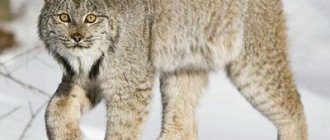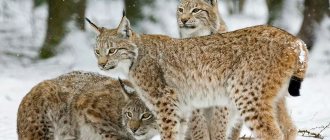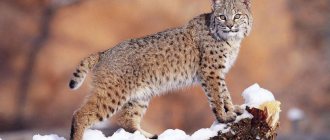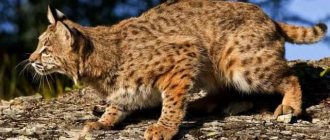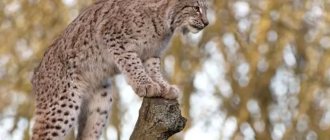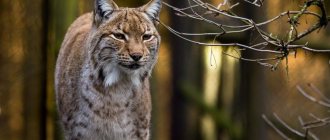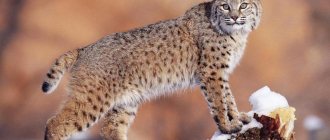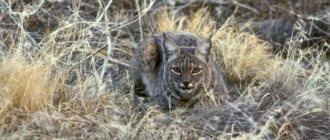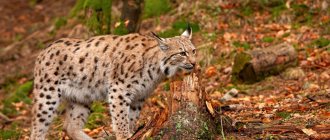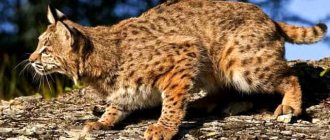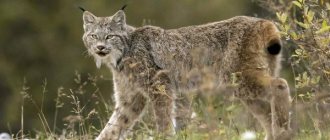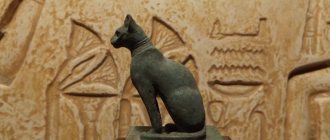7375
7376
7377
7378
7379
7380
7381
7382
7383
7384
7385
7386
7387
7388
7389
7390
The Iberian lynx (Lynx pardinus) is listed as endangered on the IUCN Red List.
Description
The Iberian lynx is similar in appearance to its close relative, the common lynx (Lynx lynx). It has a similar body size to the Canada lynx (Lynx canadensis) and bobcat (Lynx rufus). Sexual dimorphism is pronounced, males are larger than females. Spanish lynxes have relatively small heads, long legs, and very short black-tipped tails. They have short, flat snouts, black tufts on their ears, and “whiskers” on their cheeks that give them a bearded appearance, especially noticeable in adults. The fur color is yellowish-brown, with dark spots that vary greatly in size, shape and color intensity.
Since lynxes of this species hunt small animals, they have a shortened skull, which allows them to deliver the most powerful bite. They also have narrower snouts, longer jaws, and smaller fangs than felines, which specialize in large prey. These features give the lynx an advantage when catching small, fast prey, and allow it to kill prey in one bite.
External signs
The lynx has a small, graceful body, a neat muzzle, ears with beautiful dark tufts and a short tail. Body length ranges from 85 to 110 cm, and the average weight is 12–15 kg.
It is smaller in size than its closest relative, the common lynx. The fur is covered with dark spots, which makes it look like a leopard, and is shorter compared to other types of lynx. Since the animal lives in warm latitudes, there is no need for long hair with a thick undercoat.
Area
The Iberian lynx is one of two species of carnivores endemic to Europe (the other being the European mink (Mustela Lutreola)). Their historical range is limited to the Iberian Peninsula, southwestern Spain and most of Portugal. Although they were once widespread throughout the region, their geographic range has declined significantly over the past century and a half. Currently, lynxes occupy about 2% of their original range.
Measures to restore the Iberian lynx population
Since the late 20th century, much work has been done to save this species from imminent extinction through various conservation projects.
Fortunately, already based on the results of the calculations carried out in 2015, the first fruits of this enormous work can be seen. Data reports that the Iberian lynx population has quadrupled in the last 15 years.
To restore lynx numbers, Nature 2000 designated special conservation areas and LICs (sites of special importance) that indirectly protected the protected Mediterranean mountains and their fauna and flora.
Such a small population of Iberian lynx is threatened by a growing health risk associated with low genetic diversity and it is because of this that additions have been made to programs that have focused on returning the species to its natural environment, captive breeding projects have been launched to provide the species with sufficient numbers healthy animals.
The Program for the Conservation of the Endangered Iberian Lynx has two goals: on the one hand, to restore the lynx population in breeding centers, which is feasible and allows for the development of natural and assisted reproduction techniques. Secondly, to prepare individual Iberian lynx for their re-breeding in the places that this species inhabited historically.
Specifically, the goal is to conserve 85% of current genetic variation within 30 years. To achieve this goal, it is necessary to have a reproductive nucleus consisting of at least 60 individuals (30 females and 30 males).
Captive breeding programs should strive to ensure that the lynx lives in similar conditions as it did in its natural environment, which is very important especially for individuals that will be released into the wild. Specialists who work in breeding centers today strive to awaken the behavior characteristic of lynxes: hunting, territoriality, social interaction, and also to create a stress-free environment that will facilitate reproduction.
There are currently five breeding centers for Iberian lynx. Over the past year, 23 females have become pregnant as part of the breeding program. As a result, 48 Iberian lynx kittens were born and then successfully weaned. The kitten survival rate was 83%.
Video
Reproduction
Iberian lynxes, like most cats, are polygynous. Sexual maturity occurs at about 1 year of age. The female's estrus begins in January, but can recur throughout the year if the pregnancy is interrupted or the cubs die prematurely. The gestational period ranges from 63 to 73 days, and most births occur between March and April. The number of lynx cubs in a litter varies from 2 to 4. Feeding with mother's milk lasts up to 10 weeks, and complete independence occurs at 7-8 months.
Research
In August 2012, researchers announced that the Iberian lynx genome had finally been sequenced and examined. In December 2012, it became known that researchers had discovered the remains of 466 Iberian lynxes in private and museum collections. However, they estimate that about 40% of the specimens have been lost over the past 20 years.
The genetic diversity of the Iberian lynx is lower than that of any other known felids (including cheetahs ( Acinonyx jubatus)
), Ngorongoro crater lions and Eurasian lynxes in Scandinavia). Researchers believe this may be a consequence of population decline and isolation of the species.
A 2013 study showed strong genetic differentiation between the lynx populations in Doñana and Andújar, both in allele frequency and composition. The former were more different from the original population as a result of their longer isolation and smaller population size.
Nutrition
Like most felines, Spanish lynxes often hunt alone and kill prey with a single bite to the throat. Their small size and good camouflage make them excellent hunters of small mammals. Between 80 and 100% of the diet consists of European rabbit (Oryctolagus cuniculus). One adult lynx needs from 600 to 1000 kcal per day. This amount of energy is contained in the carcass of one rabbit. An adult female with cubs requires up to three rabbits per day. When European rabbits are in short supply, Iberian lynxes feed on small vertebrates, namely rodents (Rodentia) and Iberian hares (Lepus granatensis). They also consume birds, including red partridges (Alectoris rufa), ducks, and geese, and sometimes prey on young ungulates such as red deer (Cervus elaphus), fallow deer (Dama dama), and mouflon (Ovis musimon).
Notes
- Complete illustrated encyclopedia. "Mammals" Book. 2 = The New Encyclopedia of Mammals / ed. D. MacDonald. - M.: Omega, 2007. - P. 468. - 3000 copies. — ISBN 978-5-465-01346-8.
- Life of animals. In 7 volumes/ch. ed. V. E. Sokolov. — 2nd ed., revised. - M.: Education, 1989. - T. 7: Mammals / ed. V. E. Sokolova. - P. 319. - 558 p. : ill. — ISBN 5-09-001434-5.
- Fisher D., Simon N., Vincent D. The Red Book. Wildlife in danger / trans. from English, ed. A. G. Bannikova. - M.: Progress, 1976. - P. 105-106. — 478 p.
- Sokolov V. E.
Rare and endangered animals. Mammals: Reference. allowance. - M.: Higher School, 1986. - P. 23. - 519 p., l. ill. — 100,000 copies. - ↑ Simón, MA
Ten years conserving the Iberian linx. - Sevilla: Consejería de Agricultura, Pesca y Medio Ambiente, Junta de Andalucía, 2012. - ISBN 9788492807802.. - ↑
- Sunquist, M.;
Sunquist, F. Wild cats of the world. - Chicago: University of Chicago Press, 2002. - pp. 177-184.. - ISBN 9780226779997. - ISBN 0226779998. - ↑ Manuel Ansede.
Secuenciado el genoma del lince ibérico (Spanish) // Materia Publicaciones Científicas SL - ↑
Behavior
Spanish lynxes are solitary predators that exhibit social structure. They are nocturnal or crepuscular animals. The greatest activity occurs when potential prey is at its peak. Daily activities involve searching for food, usually the European rabbit (Oryctolagus cuniculus). In winter, Iberian lynxes can temporarily lead a diurnal lifestyle.
Adult females and males live in overlapping territories, and both sexes defend their territory from possible threats. When food is scarce, lynxes become aggressive and may kill other predators to reduce competition for prey. Dogs (Canis familiaris), domestic cats (Felis catus), red foxes (Vulpes Vulpes), common genets (Genetta genetta), Egyptian mongooses (Herpestes ichneumon) and otters (Lutra lutra) are often preyed upon by the Iberian lynx.
Home range
Prey density and habitat quality have a significant impact on home range size, which ranges from 4 to 20 km². They travel about 7 km a day in search of prey. Prey density is inversely proportional to home range size (higher food density = smaller home range). For example, in areas with low rabbit densities, the bobcat's home range size is 12-17 km². Where prey is more abundant, ranges vary between 5-10 km².
Interesting Facts
- The Spanish lynx has several other names: Iberian lynx; Iberian lynx; Sardinian lynx.
- The Spanish lynx lives alone and with a clearly demarcated territory. A male's territory includes the territory of several females.
- The Spanish lynx is classified as an endangered species (EN status) and is protected.
- Spanish lynx kittens at a young age (about two months) are very aggressive towards each other. They growl, bite and scratch. Their fights are not like “brotherly” games, and often such a fight can end in the death of the weaker little lynx.
- The mother moves her cubs to a new, larger den about once every 20 days.
Role in the ecosystem
Spanish lynxes regulate the population of European rabbits. These animals have very specific habitat requirements. As a result, they can serve as reliable bioindicators of ecosystem health. In addition, moderate population densities of Iberian lynx may have a positive effect on overall prey availability, as predation acts as a disease control mechanism. Finally, adult lynxes often kill their competitors (i.e., small predators), resulting in increased prey, thereby reducing territory size requirements per lynx.
Habitats
The Spanish lynx is found only in the southwestern part of the country. There are two populations living there, isolated from each other. This factor puts the species at even greater risk, since fewer individuals participate in population reproduction.
It is noteworthy that back in the middle of the last century, this type of lynx was widespread throughout the Iberian Peninsula. But today the Spanish lynx is considered a completely extinct species in Portugal. This predator prefers to live in bushes rather than in forests.
Economic significance for humans
Positive
Lynx are hunted for their valuable fur. Iberian lynxes, by controlling the rabbit population, indirectly influence the slowdown in the growth of diseases they carry, such as myxomatosis and viral hemorrhagic disease.
Negative
Attacks on livestock are very rare, and no violent attacks on humans have been recorded.
Conservation status
The Iberian lynx is one of the rarest mammal species on Earth. At the beginning of the 20th century there were about 100 thousand of them, by 1960 - already 3 thousand, by 2000 - only 400 animals. Currently, the Iberian lynx population is estimated at 250 individuals. The Iberian lynx is listed in Appendix I of CITES (Convention on International Trade in Endangered Species of Wild Fauna and Flora), as well as in the lists of the World Conservation Union (IUCN), in category I (endangered animals).
There is a program for breeding these cats in captivity. Spain plans to organize a special center where representatives of the species will be bred, and they want to create a similar center in Portugal. The first case of Iberian lynx breeding in captivity took place on March 29, 2005, and in 2006 4 kittens were born in captivity. Recently, it has been possible to establish the breeding of Iberian lynx in captivity in Spain and are being released into the wild and exported to Portugal. Zoologists have found that after a constant steady decline in the number of lynx from 2002 to 2012, its population is now beginning to gradually recover. This gave scientists grounds to move the species from critically endangered to simply endangered.
And yet, according to scientists’ forecast, the Iberian lynx may become extinct within 50 years. The researchers' findings were published in the journal Nature Climate Change. The reason for the inevitable death of the lynx is the reduction in the wild rabbit population, which makes up 80-99% of its diet. The wild rabbit, in turn, is becoming extinct due to overhunting, myxomatosis, which was introduced in 1952 from Iberia to France, and hemorrhagic fever, as well as the loss of natural habitat caused by climate change. Scientists warn that all attempts to stop the extinction of the Iberian lynx will be doomed to failure if the factor of climate change and its impact on the population of this animal is not taken into account. The Iberian lynx turned out to be little flexible in choosing food objects and continues to feed on rabbits even in conditions of a sharp reduction in their numbers. It cannot hunt large animals due to its small size.
Interestingly, to save the Iberian lynx (which is in danger of extinction), German zoologists used Triatominae killer bugs. These insects were used as a syringe to draw blood from females who were suspected of being pregnant, Science News reports. As is known, due to stress and inexperience, young lynxes quite often lose their first litter, and therefore scientists are monitoring the animals, trying to track down all the pregnant females. To confirm pregnancy, a blood test is necessary, but this procedure, using a regular syringe, requires animals to be anesthetized, which can lead to stress that increases the risk of miscarriage.
Blood-sucking bugs of the subfamily Triatominae were not chosen by chance. The proboscis of these insects is approximately 30 times thinner than the needle of ordinary syringes. They also introduce special substances into the victims’ bodies, thanks to which the animals do not feel the bite. These bugs are larger in size than mosquitoes and are able to suck more blood, but at the same time they are much easier to catch. To take blood for analysis, zoologists placed insects in special recesses with bars in cork slabs covering the floor of the room in which the lynxes lived. When the animals lay down on the floor, the insects bit them through the bars, and then the scientists lifted the bars, collected the insects, and extracted the animal's blood from their abdomens. It is noted that syringe bugs were used by scientists for a long time until a new test was developed to determine pregnancy by analyzing lynx excrement.
Communication and perception
Like all cats, Spanish lynxes have vertical pupils and excellent vision, especially at night. They have good reflexes, “whiskers” provide additional tactile sensations, and large ears allow them to catch a variety of sounds. When in danger, lynxes use vocalizations.
